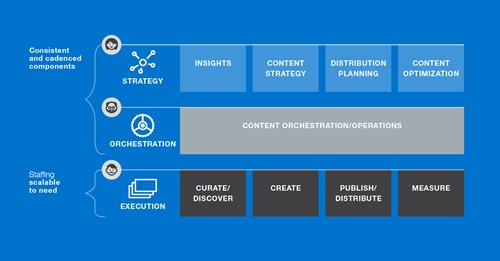How to develop high quality content at scale
02 July 2021
Content informs decisions, educates and entertains, while giving brands the opportunity to boost awareness, consideration and hopefully conversion. But content is also abundant and producing quality content at scale remains a challenge faced by teams everywhere.
In figuring out how to produce content at scale, many threw caution to the wind churning out blog posts like a sausage factory. In reality, content will only work if there is a fair exchange of value taking place whereby audiences get something in return for their time spent reading, watching or listening.
Creating high quality content requires more effort, but is still possible to develop at scale, repeatedly with the right processes in place. Read on to learn more about how to develop a scalable, repeatable content program without sacrificing on quality.
What is a content engine and why does it matter?
Content production comes with two inherent challenges. The challenge of frequency and that of quality. Production headaches usually fall into two camps:
- Bogged down in process. Content is churned out like sausages on a conveyor belt. Quality is sacrificed for the sake of hitting deadlines and reaching scale. There’s lots of content but no consistent value for the audience.
- Blighted by perfection. Content takes weeks to get through approval, there are double digit iterations. It’s impossible to get into any sort of production rhythm and there are large time gaps between each piece of content.
In addition to these hurdles, the time it takes to create content is increasing. In 2014, it took an average of 2 hours and 24 minutes to produce a blog post; in 2019, that had increased to 3 hours and 57 minutes. The solution to these numerous challenges: a content engine.
A content engine is an established and polished framework for producing content, detailing the steps that need to be taken to produce good content and putting them into a repeatable formula. It takes the guesswork out of the process and keeps things straightforward so that everyone involved can rely on the predictable rhythm it creates. Helpful if you consistently need to put out quality copy.
Establishing an operating model
The first step in creating a content engine is understanding and establishing the layers of accountability. This informs the composition of the team, outlines their responsibilities and defines where they can integrate and work together.
There are three distinct layers of accountability, each with clear roles and responsibilities. These are Strategy, Orchestration and Execution. It’s critical that these three elements run concurrently and not in silos, otherwise inefficiencies will continue.


A lot of planning and collaboration must go into building a content engine; this system cannot be implemented or managed by one person. A team must be involved, and roles assigned ahead of time, to maximize efficiency and provide layers of accountability.
Certain roles will need to be focused on strategy, others on orchestration, and others on execution. Which roles will tackle each category and who has ownership over each stage of the process? It’s best to create an operating model that outlines what needs to be done, by who and at which point during production.
Assembling the right team
Next, you need to figure out who should be filling each role outlined in the operating model. Questions like these can help you figure out next steps:
- What roles do you already have filled in your organization?
- Which need to be filled from the outside, whether that’s hiring new team members or outsourcing to an agency partner?
The most important thing is that each role’s responsibilities are clearly laid out and that accountability is upheld. Ownership must be made clear.
Establishing the building blocks
Finally, you must lay out the building blocks. What outputs should be expected from each team, and how can you make the production process repeatable?
Strategy must consider creating a Fair Exchange of Value whereby content actively gives back to the audience. Drill down into why content is being created and who for, what the business will get out of producing said content, and why the audience should bother taking the time to consume it. Additionally, it’s during this step that you examine the overall strategy and document it; consider the possible platforms first understanding which are the most relevant to your audience.
Orchestration must consider the day-to-day management of content delivery and style. Which tools are needed, are there editorial guidelines and a calendar in place, and how will content be maintained on digital platforms? Thinking about scale, speed, consistency, purpose and relevancy is important here.
Finally, execution will be establishing the strategic production workflow noting down exactly how you’ll move from ideation through to creation and measurement, all while focusing on producing quality on a repeatable basis.
Getting started
Each part of the content engine must be functional so that you can produce quality content at scale. Questions around who is responsible for what or when things are due are answered, as the system is already in place. The production process is repeatable, streamlining production and allowing teams to accurately run calendars and gather consistent metrics to learn from.
This week we launch our latest report, Building a Content Engine: How to build a scalable, repeatable model for great corporate storytelling. If you want to learn more putting the frameworks in place to develop high quality content at scale, you can read the report here.




